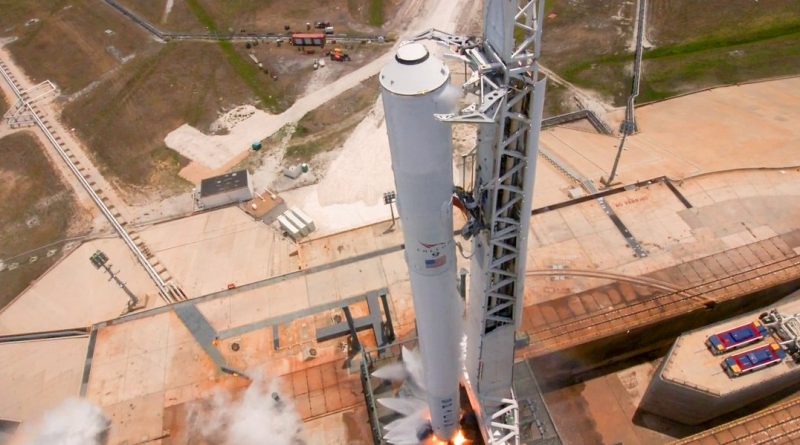Falcon 9 completes Hold-Down Engine Test as SpaceX accelerates Launch Pace
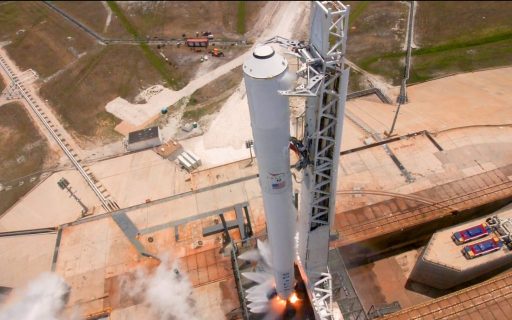
Sustaining a rapid turnaround pace at the company’s Kennedy Space Center Launch Pad, a SpaceX Falcon 9 rocket lit up its engines on Thursday in a final end-to-end test ahead of liftoff as early as Monday night with a high-power communications satellite for London-based operator Inmarsat.
Keeping the pedal on the metal, SpaceX continues on course to achieving seven launches in a period of three months – a record for the California-based company that aims for a steady two-week cadence for missions from Florida with occasional flights from the West Coast. On the manifest through the end of June are two Geostationary deliveries using expendable Falcon 9 rockets, the next Dragon mission to the Space Station and the second Iridium-NEXT mission from Vandenberg.
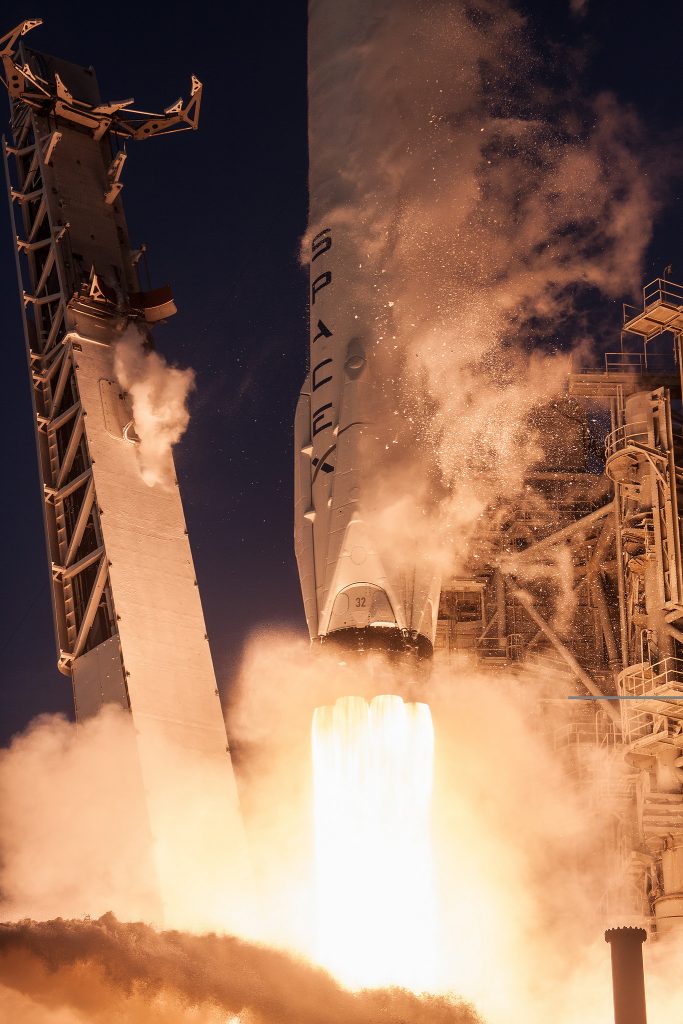
The biggest challenge in recent years for SpaceX was reaching a steady launch pace to deal with an increasingly crowded manifest and two mishaps – one during flight in 2015 and last year’s on-pad explosion – further slowed the company’s progress by keeping Falcon 9 on the ground for ten months.
Other issues included bottlenecks in rocket production that are being solved as re-flight missions begin to become more common with BulgariaSat-1, currently set for launch in mid-June, expected to be the next satellite to ride on a flight-proven rocket. Other issues like payload-related delays or complex scheduling of ISS missions will become less of a problem once SpaceX’s other Cape Canaveral launch pad becomes available again later this summer.
Since coming back to flight in January, SpaceX checked off five successful missions and managed to achieve a two-week turnaround time at Launch Complex 39A, although the most recent mission with NROL-76 slipped two weeks due to the payload.
SpaceX’s busiest year to date was 2016 with eight launches; barring any missteps, the number for 2017 should be substantially higher – in the 20-to-25 ball park according to SpaceX chief Elon Musk.
Next on the firing line is the Inmarsat 5-F4 mission, a rare expendable Falcon 9 launch and its heaviest haul to Geostationary Transfer Orbit to date with a payload upmass of 6,070 Kilograms.
Inmarsat 5-F4 is a powerful mobile communications satellite built by Boeing and operated by Inmarsat as the fourth and last member of the $1.6-billion Global Xpress satellite constellation that delivers seamless global Ka-Band coverage to provide broadband connectivity to airplane passengers and ships sailing the world’s oceans.
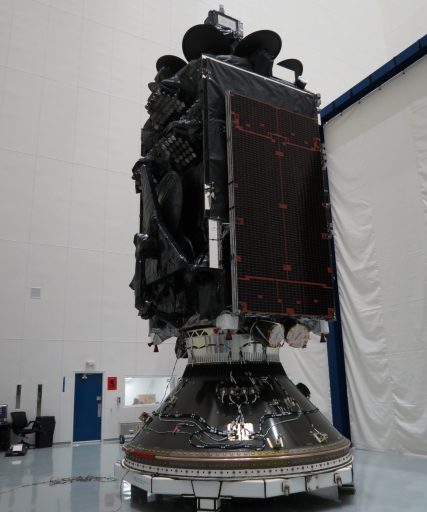
Initially, Inmarsat designed Global Xpress as a three-satellite constellation which launched atop Russian Proton boosters in 2013 and 2015, but early on, it was decided to add a fourth spacecraft to the series – either acting as an early spare to ensure continuous global coverage or use it as a reinforcement over areas of rising broadband demand.
The launch contract for Inmarsat 5-F4 was awarded to SpaceX back in 2014 and the satellite was initially looking forward to a 2016 ride on the Falcon Heavy rocket. However, with Falcon Heavy’s debut repeatedly slipping, a built-in contract option was exercised to switch the satellite to the Falcon 9.
While Falcon Heavy could have lifted the satellite in a fully reusable configuration, the less-powerful Falcon 9 will have to fly expendable, stripped of landing legs, grid fins and other re-usability modifications.
Based on Boeing’s High-Power BSS-702HP platform, Inmarsat 5-F4 hosts 89 high-throughput Ka-Band transponders feeding a pair of transmit & two receive apertures plus six steerable beams with higher power to direct focused coverage where it is needed. The satellite supports user data speeds of 50Mbps for download and uplink at 5Mbps, catered to high-speed mobile broadband communications to maritime, aeronautical, enterprise and government customers. Specific services include data services for deep sea vessels, in-flight connectivity for airplane passengers, high-resolution video streaming, voice and data for the enterprise sector.
>>Inmarsat 5-F4 Satellite Overview
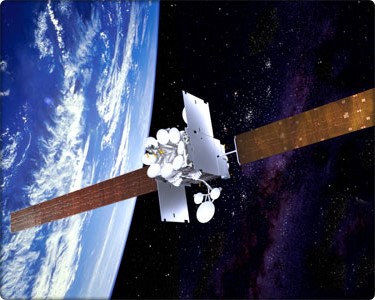
Inmarsat 5-F4 arrived at Florida’s Space Coast last month after a cross-country trip from Boeing’s El Segundo, California facility to enter a final phase of pre-launch processing. The spacecraft was put through a last set of tests, received 2,437 Kilograms of Hydrazine and Nitrogen Tetroxide propellants and was attached to its RUAG-built payload adapter ahead of encapsulation in the payload fairing this week.
Meanwhile, inside the SpaceX hangar next to the Complex 39A launch pad, technicians assembled the two-stage Falcon 9 and mated it to its Transporter, Erector, Launcher (TEL) on Wednesday ahead of rollout to the pad Thursday morning for the hold-down fire test. Still missing its payload, the 57-meter tall stack was transitioned to a vertical position and final hands-on work was completed before the pad was cleared for the propellant loading operation.
SpaceX has conducted Static Fire Tests ahead of all its missions, acting as a final end-to-end test of all launch vehicle and ground systems to uncover any problems prior to launch day. The test comprises an abbreviated countdown sequence, starting with the activation of the rocket and a series of tests before a 70-minute tanking sequence to load both stages with over 500 metric tons of chilled Rocket Propellant 1 and sub-cooled Liquid Oxygen plus Helium tank pressurization gas.
Although the second stage is only a bystander to the hot fire test on the first stage, it too undergoes fueling and pressurization to cycle all of its systems, including valve and steering tests on the MVac upper stage engine.
F9/Inmarsat: The view from the roof of the CBS bureau at KSC: pic.twitter.com/Zw6BZwltFt
— William Harwood (@cbs_spacenews) May 11, 2017
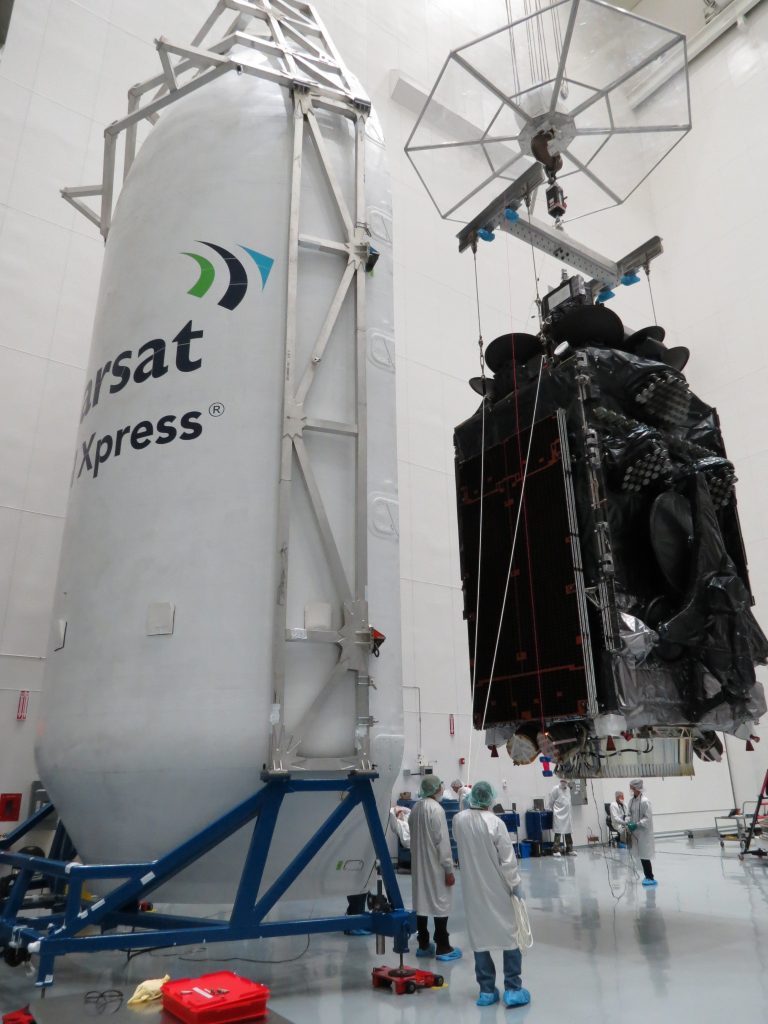
The day’s operation was very smooth and SpaceX set a T-0 of 16:45 UTC, only 45 minutes into a six-hour test window. Venting from the rocket’s Strongback confirmed Falcon 9 was being loaded with supercold LOX and the last seven minutes saw dozens of countdown events checked off, including chilldown of the nine Merlin 1D engines, transition to battery power, retraction of the Strongback and handoff to Falcon’s computers.
Flames erupted from the historic LC-39A flame trench right on time at 12:45 p.m. local time as the nine Merlin 1D engines throttled to a collective thrust of nearly 700 metric-ton-force to collect performance data. Per the typical procedure, the Launch Team went into safing of the rocket while an engineering team quickly reviewed data to confirm all required parameters were captured and the firing met the planned duration to give the green light for de-tanking.
Once returned to a fully safe configuration with all tanks drained, Falcon 9 will be moved horizontal and rolled back into the hangar to meet its payload over the weekend. The fully assembled launch vehicle will roll out to the former Saturn V and Shuttle launch pad on Sunday or Monday morning to enter a lengthy countdown.
Monday’s 50-minute launch window opens at 23:20 UTC, 7:20 p.m. local time, an hour before the sun sets over Cape Canaveral.

Falcon 9 will be in action for a little over half an hour – firing its first stage for over two and a half minutes before handing off to the second stage that will first deliver the stack to a Low Earth Parking Orbit ahead of coasting and re-lighting the engine close to the equator to boost Inmarsat 5-F4 to its elliptical drop-off point. From there, the spacecraft will fire its main engine several times over a period of days to circularize its orbit 35,800 Kilometers over the equator to match the speed of Earth’s rotation.
Inmarsat said the 5-F4 satellite would first start services over Europe, supplementing coverage provided by Inmarsat 5-F1. If not needed to replace one of the three constellation satellites, Inmarsat 5-F4 could be operated in different orbital positions supporting business opportunities that can vary over the craft’s 15-year design life.
Provided Monday’s launch occurs on time or the backup slot, SpaceX will shift focus to the Dragon SpX-11 mission, set for liftoff on June 1st at 21:55 UTC to send nearly 2,700 Kilograms of hardware, supplies and experiments to ISS as well as three external payloads to test a new type of solar array, study neutron stars and deliver hyperspectral imagery of Earth. Dragon is being loaded with supplies this month while the three external payloads have already taken their place in the Trunk Section. The SpX-11 mission will be the first re-flight of a Dragon pressure vessel, though much of the craft’s avionics are brand new.
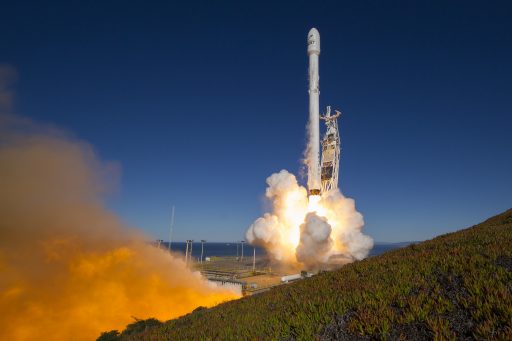
Next in line after Dragon is Bulgaria’s first Geostationary Communications Satellite that took advantage of jumping ahead in SpaceX’s manifest by opting for a flight-proven booster – avoiding the production bottleneck. Liftoff is set for June 15, marking the second flight for the B1029 first stage that first flew in January 2017 from Vandenberg – becoming the first booster to lift off from both U.S. Coasts.
The end of June could see two Falcon 9 launches in close succession with Iridium-NEXT on the Western Range for June 29 and Intelsat 35e currently aiming for a late June target. SpaceX is hopeful to keep up a two-week launch cadence for much of this year to deliver more commercial satellites to GTO, send Dragons to the Space Station and get Falcon Heavy off the ground on its long-awaited debut mission.
SpaceX test fired the first Falcon Heavy core stage at the company’s McGregor facility in Texas last week, marking visible progress toward the late summer demo mission that will feature a new core stage plus two previously flown side boosters and, possibly, a second stage fitted for a return experiment.
First static fire test of a Falcon Heavy center core completed at our McGregor, TX rocket development facility last week. pic.twitter.com/tHUHc1QiKG
— SpaceX (@SpaceX) May 9, 2017

